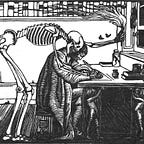What’s Creative Coding? — My Journey at GROW Festival
Spoiler alert: it’s not about coming up with original passwords.
If you happened to pass by Paris bar and event space Ground Control mid-November, you would have bumped into a purple hologram ball reacting to the sound of your voice, a self directed wall drawing, and a passionate bunch of European developers, designers and artists, avidly listening to peers’ talks. Welcome to the second edition of GROW festival, “the Parisian rendez-vous for creative coders.”
Nicolas Barradeau, the mastermind behind the event (organized by communications agency Spintank), couldn’t be happier about the result: “there are talents out there, who don’t get the spotlight they deserve — but on the bright side, creative coding is starting to be taught in schools, and I see more coders being sensitive to design, and vice-versa.” Next year, he wants to festival to be bigger, bolder … and funded.
In a growing Parisian tech scene, it’s surprising to hear sponsors turned down the opportunity to support an event gathering some of the brightest minds in programming. But that might be because creative coders think out of the corporate box, and definitely favour fun over function.
Alright, time for the definition!
In a nutshell, creative coding is the use of programming languages to create surprising visual results. Think websites of course, but also interactive installations, video games, and even paintings.
There’s no technical prerequisite to get into creative coding –except a love for tinkering. Sabrina Verhage, an architect by training, remembers falling in love with Processing, a language for learning how to code within the context of the visual arts, and incorporating it into her practice. She is now a designer, and hosts meetups in Amsterdam to gather the community.
Programming can seem a solitary, “me behind my computer screen” task. But it’s actually a very collaborative culture, with the use of open source software and code sharing. A stance that extends from the technical to the political, embraced by participants. A choice that creates ambiguity and tension too. Deborah Schmidt, an open source developer at the Max Plank Institute in Dresden, had decided not to encrypt her final masters project so that others could hack it and use its functionalities, drawing on walls with light. She then published the code on GitHub, but it was never forked (used for a different program). Opening up the data isn’t enough, you also need to work on documentation and maintenance: time consuming tasks that are not always compatible with a full-time job.
Someone in the audience also raised an “Obvious” question. The Parisian collective of the same name saw one of its work sell for $430, 000 in Christie’s New York in October. The press loved the promise of “the first work created by AI sold at an auction” — artists who had been working with the medium for years, not so much. To create the imaginary portrait of an 18th century Baron, Obvious used Generative Adversarial Networks (GANs for short). The technique consists in training two neuronal networks in parallel, on a large set of images: one generates images “in the style of”, and the other checks whether they are known or not. The process stops when the “forger” fools the “controler.” The method was created by Alec Radford in 2014 and used by a few artists, including Robbie Barrat, a 19 years-old “GANer” who accused Obvious of stealing his code. But since it has always been open-sourced, the reproach can only be ethical.
Tech Art, but still tech
The mere mention of neural networks gave you a headache? Wait till you discover there are manuals dedicated to physics for 3D modelling. “Tinkerers” often have a solid technical background — their genius lies in making us forget about it. True, you don’t need to know the number of lines of code that went into creating you favourite video game. But what if the process was itself the result?
Artist Mario Klingemann also works with GANs, but he doesn’t consider the final creation as a self-standing piece, cut off from the algorithm that fuelled it. “I can generate an infinity of images, all I do is pick one or another, but the artificial intelligence is also part of the work.” Which is why he has shown his pieces on TV monitors, with the hardware running the program also on display.
The worlds of tech and contemporary art rarely share the same conceptual concerns. Luba Eliott, a curator, artist and researcher specialising in artificial intelligence in the creative industries, recalls the “excitement” brought by a technology like style transfer in the research community, whereas it provokes at best a shrug in art critics. With style transfer, take a picture of your dog and it becomes a Van Gogh painting. Technically impressive, but visually boring, after a few tries. It’s all about connecting technical complexity to broader social issues. From global surveillance to algorithmic bias, topics abound.
But are creative coders artists? Not for UK-based creative technologist Edan Kwan: “I’m not an artist, I can’t create things out of thin air, what I like is solving problems.” Let’s not dwell on this particular definition of the artist: what counts is a more relaxed approach to creation, seen through the scope of discovery. A way of thinking mirrored by Yi-Wen Lin, who created an interactive installation based on the movement of Koi fish, to his children’s delight.
At the end of the day, everyone was drained by a ten-hour spree of conferences, but left inspired and energized. While we wait for the next edition of Grow, who’s up for creating this emoji password generator?
